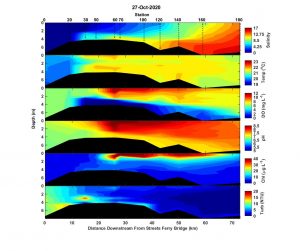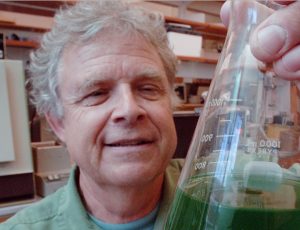Hi all,
The fish kill that started in late September was still occurring on 27 October. Dying and dead peanut sized (~3″) menhaden were observed from station 70 to station 100. This area seems to be where most of the fish kill activity has been observed. Many of the fish had sores consistent with infection by the water mold, Aphanomyces invadans. In the fish kill zone, water temperatures near 20C and salinities of 5 or less are optimal for growth of A. invadans.
The estuary was highly stratified from New Bern to station 160 and hypoxic bottom waters extended downstream to station 160. Anoxic conditions, indicated by the smell of sulfide, occurred at station 50 through 100. Anoxia is unusual but occasionally occurs during the hottest, calmest periods of the summer when there is moderately high river flow. I don’t recall ever seeing anoxic conditions this late in the season. High chlorophyll a levels were observed near the surface from stations 60 to 160.
Surface waters from station 70 were observed microscopically. The bloom was primarily dominated by the dinoflagellate Gyrodinium instriatum which is not known to be toxic or cause fish kills. Lesser cell densities of the potentially harmful raphidophyte, Heterosigma akashiwo, were also observed. While Heterosigma akashiwo has been repeatedly associated with fish kills in other estuaries, this fall is the first time I am aware of that it has been associated with a fish kill in NC waters. I strongly caution that this association does not imply that H. akashiwo was responsible for the fish kills.
State funding for ModMon has expired. ModMon monitoring activities and these associated reports will be suspended while we pursue other funding options.
Stay well,
Nathan

